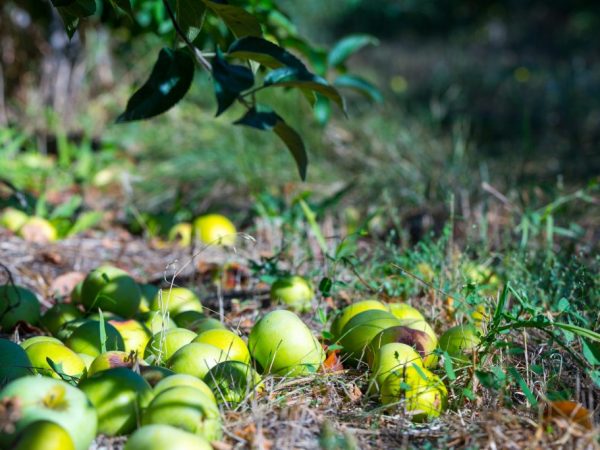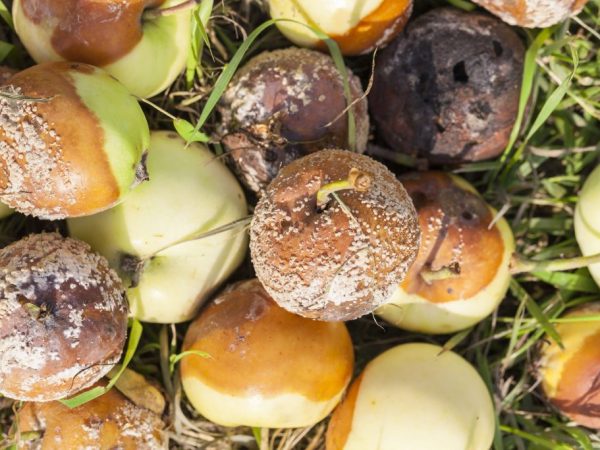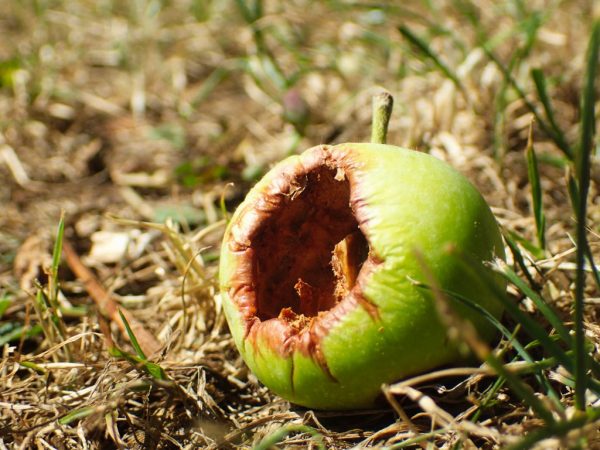Reasons for falling apples
There are several reasons why apples fall off during the early ripening and harvesting phases. This phenomenon is caused by improper care, damage to trees by diseases and pests. Useful advice from experienced gardeners will help you take action in time and avoid crop loss.

Reasons for falling apples
Common Causes
Scattering of unripe fruits can be caused by an attack of an apple orchard with diseases and parasites, or improper care. Also, subsidence can occur for natural reasons.
Natural process
Up to 50 thousand small apples can form on one adult tree per season.
With a heavy load on the branches, the apple tree begins to partially shed fruit ovaries.
Also, shedding can be caused by a natural process: at the end of June, the tree sheds fruits up to 1.5 cm in size. At the same time, it leaves the required amount of fruit, which it can give full nutrition until it is fully ripe.
Sometimes apples reach full maturity ahead of time. The process is typical for such varieties: Grushovka Moskovskaya, Iyulskoe Chernenko, Mayak, Dessertnoe Isaeva, Solntsedar, Mantet.
Improper care
Sometimes apples fall ahead of schedule due to non-observance of agricultural practices.
- Irregular and insufficient watering leads to an incorrect distribution of moisture, which is only spent on the development of the root system, shoots and foliage, and the fruits fall off immature. Usually varieties with a shallow root system and grafted on a dwarf rootstock are susceptible to this. The same phenomenon is possible with excessive watering, when the root system suffers from a lack of oxygen and is unable to provide moisture to other parts of the tree.
- With a lack of nutrients in the soil, trees cannot keep the entire crop and begin to shed it. Such a process is possible with an excess of nutrients, especially with an excess of nitrogen (it begins to intensively grow shoots and leaves, and small fruits can crumble).
- In the absence of preventive treatments, the apple tree can hurt, as a result of which it sheds the ovaries and already ripe fruits.
- Freezing of fruit branches and flower buds and the lack of annual sanitary pruning in young trees and rejuvenating pruning in adults can also affect the early release.
Diseases and pests
The most inveterate pest of the apple orchard is the moth - this parasite eats away the fruits from the inside and leads to their spoilage and shedding.
Apple sawfly, weevil beetle also love to feast on juicy fruits on the tree. Typically, these parasites colonize during the ripening period and result in a 50% loss of yield.
Of the fungal diseases that provoke such a process, they secrete scab and monilial burn.
Other reasons

Rotting apples can begin due to high humidity.
Shedding of green or ripe fruits can be caused by decay, cracking, or deformation. The crop loses not only marketable, but also taste:
- Fruits rot for several reasons: infection of the tree by harmful insects, fungal infections, excessive moisture and dampness. Small cracks appear on the apples, as a result of which they begin to rot and quickly deteriorate.
- Fading. Reasons: overload of fruit branches, lack of moisture and calcium in the soil, thickening of the garden and tree crowns, the age of the apple tree. To avoid this phenomenon, it is necessary to normalize the ovaries, rejuvenate old specimens and cut out unnecessary branches. It is also important to keep your distance when landing.
- If the fruit is bitter, it is a sign of damage to the trees by Jonathan spot or bitter pitting. Caused by a lack of potassium, magnesium and calcium. Complex nutrition from these components will help to avoid this phenomenon.
- Deformation of the fruit. The formation of bulging growths and cracks is a clear sign of scab. The same phenomenon is possible in the case of damage to flower buds by spring frosts, hail or sawfly. For preventive purposes, the crown is sprayed with copper sulfate or Bordeaux mixture. Trees are sheltered from freezing for the winter - they spud the near-trunk zone, and cover the trunk with spruce branches or wrap it up with roofing material. In the fight with the sawfly, insecticides are used - Actellik or Fundazol (processing is carried out at the initial stage of fruit formation). Damage to the skin of the fruit in the form of scratches and warts is a sign of a weevil beetle. Insects are harvested by hand - in the early morning they spread a blanket under the tree, shake off the insects and burn them. Then the soil and crown are sprayed with Confidor or Antizhuk.
- A change in the color of the core in fruits occurs under the influence of high humidity, frequent rains and overflows of the tree.
Optimization of care
For full growth, development, formation and ripening of fruits, an apple tree needs to be provided with competent and timely care.
Irrigation technique
For the safety of the crop, it is first of all necessary to adjust the watering - the soil is moistened to a depth of 0.5 m.
During the entire season, trees should be watered at least 5 times:
- in early spring;
- before flowering and three weeks after natural shedding;
- in June - at the stage of fruit formation;
- before harvesting - 14 days;
- after falling leaves in mid or late October.
If the summer is dry, the frequency of watering is increased - the plants are watered as the earth dries up.
For dwarf varieties with superficial roots, watering is carried out at least once every 2 weeks. To retain moisture, the near-trunk zone is mulched with peat, humus or garden soil.
Balanced diet

The tree must be properly fertilized
For the full formation of fruits and their ripening, the tree must be provided with proper nutrition.
For better digestibility of nutrients, fertilizing is combined with irrigation:
- at the stage of the appearance of flowers, fertilize with potassium salt, superphosphate and urea solution;
- during the pouring of fruits, sodium humate and a solution of nitrophoska are introduced;
- after harvesting - superphosphate and potassium sulfate.
The dosage is applied according to the instructions and in accordance with the age of the tree.
Pruning
Particular attention should be paid to old trees (they often drop apples while still green). To stimulate growth, five-year-old branches are cut out on a ring, all damaged shoots are removed.
Pruning is also important for a young apple tree - it is carried out every spring. The crown is thinned out, all shoots are trimmed by a third of the length, and damaged branches are also removed.
To increase yields, it is necessary to ensure the massive attraction of beneficial insects that pollinate apple trees. For this, useful field and garden vegetation is planted in the garden - phacelia, black root, mattiola, Moldavian snakehead.
Destruction of parasites
You can exterminate the codling moth by spraying the crown with insecticides - Alatar, Kinmiks, Bi-58, Iskra M. These preparations destroy butterfly caterpillars that eat the flesh of the fruit.
During the summer period, chemical agents are used against insects - Gerold or Dimilin. In the phase of fruit ripening, biological products are used - Bitobixacellin or Fitoverm.
To combat the sawfly and the weevil beetle, the crown is sprayed with preparations - Confidor, Callipso or Antizhuk. The solution is prepared according to the instructions, spraying is carried out at least 3 times with an interval of 10 days.
Preventive actions:
- set trapping belts, pheromone traps;
- fallen apples are picked in time;
- clean the bark from damaged areas, treat the trunks with slaked lime;
- in the fall, the site is dug up.
From folk remedies for the moth, sawfly and weevil beetle, infusions of bitter pepper, garlic, wormwood and tobacco are used. Treatment with such means is carried out in early spring, before flowering trees and in autumn, after leaf fall.
Additionally, the soil around the near-trunk zone is irrigated, since the caterpillars and larvae of insects crumble after harvest, pupate and winter in the soil.
Fight disease

Diseased fruits and leaves must be destroyed
The fight against scab and moniliosis is carried out in several stages:
- first, the site is cleared of vegetation remnants, the carrion is removed;
- all the fallen leaves on the site are laid in a compost heap or burned;
- digging up the soil around the near-trunk zone;
- ailing specimens and the soil around them are sprayed with a urea solution, and in early spring - with a Bordeaux liquid.
Several drugs will help get rid of a fungal infection - Raek, Horus, Skor, Gamarin or Fitoverm. Plants are processed three times at intervals of 10 days. Plants with weak immunity are treated five times per season. It is advisable to spray trees a month before the planned harvest.
What to do with fallen apples
Fruits that were affected by the moth and fell to the ground are not suitable for human consumption. They are immediately collected and burned, since the caterpillars that live inside the fruit can burrow into the soil for pupation or move to healthy specimens.
Fallen apples affected by fungal infection or green carrion must also be disposed of, because it is a health hazard.
Fruits that are not ripe, cracked and fell can be used for further processing - put for drying, mashed potatoes, cider and other preparations.
With fruits that have fallen early, you can do the following - place them in a warm place for ripening (the optimum temperature is 21-23 °, humidity is 60%). Autumn varieties ripen for about 2 weeks, winter - 2 months.
Conclusion
It is not so difficult to prevent shedding of fruits on an apple tree - the main thing is to provide the trees with proper care, carry out preventive treatments against diseases and parasites, keep the site clean and dig it up regularly.

